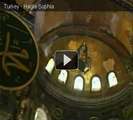Turkey Pamukkale
The stunning white calcium pools, which cling to the side of a ridge, have long been one of the most famous picture postcard views of Turkey. Pamukkale, literally meaning "cotton castle", is also the site of the ancient city of Hierapolis of which there are many interesting ruins, and is a very popular destination for a short visit.
Pamukkale was formed when a spring with a high content of dissolved calcium bicarbonate cascaded over the edge of the cliff, which cooled and hardened leaving calcium deposits. This formed into natural pools, shelves and ridges, which tourists could plunge and splash in the warm water.
Hotels were springing up from the 1970s to cater for the large influx of tourists, and shortly afterwards UNESCO declared it a World Heritage Site. But by the 1990s, this took its toll on the state of the calcium pools and restrictions were placed on these travertine terraces. Many hotels were knocked down, visitors are only allowed on major paths around the sites, and must remove footwear to stand on the calcium deposits. This seems to have been a successful move, as the water supply is now used for preservation and some of the damaged calcium deposits have been strengthened.
![]()





No comments:
Post a Comment